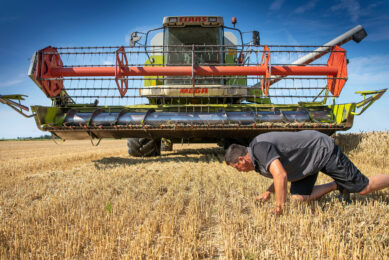Septoria risk near the average

The risk of septoria disease in wheat is predicted to be near the 10-year average this season, according to the first early season national forecast.
Only East Anglia shows a slight rise in the forecast risk of the single most important yield-sapping wheat disease in the UK.
This prediction came from CropMonitor, an online pest and disease alert service run by the UK government’s Food and Environment Research Agency (FERA).
The early forecast is useful in giving growers an idea of disease risk for the season ahead, says Judith Turner, FERA plant pathologist who manages CropMonitor.
She urges growers to check the weekly alerts to refine their fungicide programmes as the season progresses. “Last season was a classical example of having to change plans. What looked like moderate risk at the start of the year, turned out to be a high pressure year and CropMonitor was valuable in showing increasing risk as the wet weather arrived,” she adds.
One useful service is the intensive monitoring. “If you want to know if there is any inoculum in the bottom of the crop, select the leaf layer tab to see if there are any reports of disease,” Dr Turner says.
With septoria, there can be a lag time of a few weeks between the rain splashing and it appearing in the crop. The monitor doesn’t just report on septoria, growers can also benefit from disease risk ratings for brown and yellow rust. “Rust is much more explosive and you see it much quicker in your crop, so early detection is more valuable,” says Dr Turner.
One way to gain a little extra time is to monitor regions that are historically the first to be hit by the disease. “For example, brown rust is often first seen in Kent, so growers in other parts of England can gain some extra time. Similarly, the South-west is prone to septoria,” she says.
Another disease that is in the minds of growers from last year is fusarium ear blight, which hit many crops last summer resulting in poor grain quality. However, the risk looks lower this coming season, because of the wet, cold weather.
FERA disease specialist Phil Jennings points out that a bad season would normally be preceded by a build up of inoculum in a warm, dry autumn followed by a warm dry spring.
“In 2000, when we last saw a wet autumn, the following year’s crop had virtually no microdochium on the ears and Fusarium graminarium levels were reduced.
“So looking ahead after the wet, cold winter, it is not going to be such a high risk year [for both microdochium and Fusarium graminarium]. But if we get a warm dry spring, we don’t know how the inoculum will respond, so regular in-season observations will be crucial,” he says.
CropMonitor – how it works
1. Weekly in-season reports
Weekly monitoring is carried out at 13 trial sites across England with blocks of 15 varieties. Plants are examined weekly from growth stage 30 to 75 and scored for septoria, and yellow and brown rust.
These disease scores for the different varieties are then entered into a model, together with weather data from 110 stations across England and Wales to predict the risk rating for the 15 regions. In addition to Septoria tritici, yellow rust and brown rust the plots are also assessed each week for the other major foliar diseases of wheat such as powdery mildew.
2. Intensive monitoring reports
At five sites (Andover, Callow, Canterbury, Terrington and York), more intensive weekly monitoring is carried out to assess disease (including fusarium ear blight) in the different leaf layers using four indicator varieties.
Source: FWI











